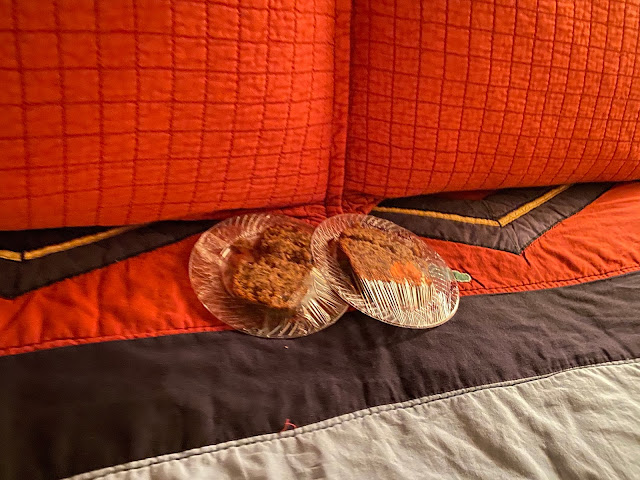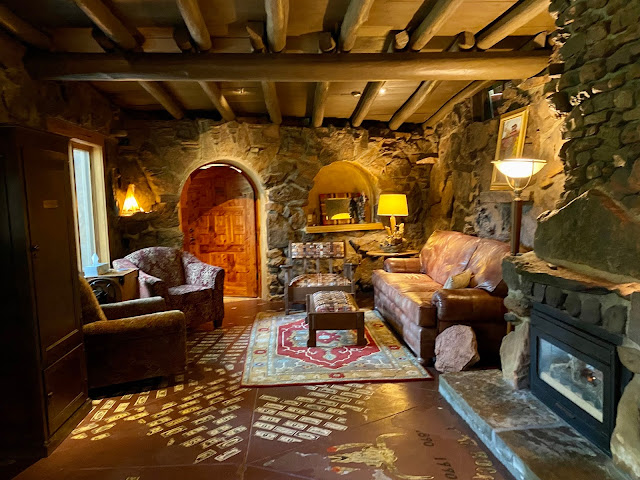First of all, let me say this. In the modern world, when you don't know something, the new verb phrase is "just google it." But the hubby and I like to debate the minutiae of all things in life. So we haggalled about whether we were going to the Prairie or the Midwest.
I said both.
Yes we had anchor points for our tromp around this 4 state region of the midwest, and I begin with the places we stayed.
Usually we roll deep and strive to see and do as much as we can (practicing the "we may never pass this way again" motto), so where we lay our heads does not matter.
This time it was different. We had 2 specific sleeping places that required pre-registration and two stumble-upons of note.
Here we go:
There were a variety of reasons for exploring Oklahoma- mostly to look into the troubled past of the area and see how things are today.
The history is old. Older than my New England history books or mid-60's and 70's television shows' knowledge.
Land acknowledgements need to be here, for they explain some of the history.
Tulsa and all of Oklahoma, formerly known as "Indian Territory" became an area overrun with settler colonialism.
Today, 39 tribal nations dwell in the state of Oklahoma as a result of settler and colonial policies that were designed to assimilate Native people.
The city of Tulsa is within the tribal boundaries of three of these tribes: the Cherokee Nation, Muscogee (Creek) Nation, and Osage Nation.
I acknowledge, honor and respect the diverse Indigenous peoples connected to this land.
Much work is being done to dismantle the egregious effects of the settler colonialism and its awful attempts at erasures and exclusions of Native folk. They are still here and I came to visit and bear witness to the trials and tribulations they faced. To try to see and understand what it is like on the Prairie in the 21st century.
In searching for a place to stay, this area B+B/Inn came up for its early history tied to Native People: STAY PLACE 1
Depending on where you get your information, there is either NOTHING or very little on the real history behind this place.For instance, check out the website, "Only in Your State" for Oklahoma: https://www.onlyinyourstate.com/oklahoma/cedar-rock-inn-ok/
Even knowing the family name did not produce reams of literature on this site or the family's accomplishments. I scrambled to find out if there was a book I could purchase to learn more. One museum either did not know and/or feigned ignorance when I called to inquire. The woman took my name and number, vowed to check their library and bookstore and call me back- she never did.
The family name was Perryman and their history is one of mixed heritage, a phenomena that has happened for many of us here in the melting pot USA. The Perrymans didn't start in Tulsa (as was the case for many tribes that were expelled from their tribal lands in that awful period of US history), but instead migrated from the Georgia area.
The family’s legacy began with Benjamin Perryman, the son of a Welsh trader and a Creek Indian woman. Tecumseh Perryman, a member of the Creek tribe/Perryman family, was the original owner of this property.
The Perryman family were some of the original founders of Tulsa, Oklahoma. There is a nice article about this family at: https://www.tulsapeople.com/family-ties/article_748f5e6d-ba26-5b49-95ad-9d22f1690d50.html
However, Tecumseh is not mentioned. Very hard to find out information about this Perryman descendant. What is known: the first floor of the dwelling – made from rocks – was originally a home built in 1890 and owned by Tecumseh Perryman. He was descended from Creek Nation Indians and an allotee of land from the Federal Government. Allegedly, Tecumseh was only 17 when he came to own this land.
The history of land stealing goes back as far as the first immigrant footsteps on North American soil. How and why this was done will be forever debated. The fact is that it was done. Here in the US we had our own particular way of "acquiring" Indigenous land.
The U.S. federal government began the policy of allotting Indian land as early as 1798. Several treaties with Indian tribes included provisions that stated land would be divided among their individual members. After 1871, however, Congress declared that no further treaties would be made and all future dealings with Indians would be conducted through legislation.
Yup, much like this area- known for its huge cattle ranches, cow towns, and long arduous cattle drives, the US government removed thousands of Eastern Indigenous folk to this new land in Oklahoma "Indian Territory," and began a series of head-scratching, convoluted laws on land allotments.
Tecumseh Perryman becomes lost in history accepting this exceptional preservation piece of land. We were awed and thankful to score this night's stay. Much ado has been made over the current owners 6 year renovation efforts. It really is a beautiful property. We had the additional great fortune to have the entire property to ourselves! We stayed in the Tecumseh section though, which was a bit dark and tiny bit scary.
Along with the requisite painting of the Inn on the rock walls.
Of course I had to take a picture in the mirror to see if any apparitions showed up with me. NONE. Nor any spooky knocks in the night (unless you count my husbands snores, which sometimes include knocking snorts).
A surprise treat was to find the new construction was done with labeled bricks thrown in. How'd they know I am a labeled brick enthusiast!?
Sure wish I had found that one (Pawhuska OK)! We went to this town later on our sojourn.
And we stayed in this BIG brick-making former cow town.
Hot damn if we didn't score one...
Or two!!!!!!!!!!!!!!!!!!!!!!!
We could see the tower as we drove into town. The anticipatory thrill was an awesome feeling.
The gorgeous, signature green of FLW- what a sight!
Not originally built as a Hotel/Inn, it only became so in 2003. The Price Tower is a nineteen-story, 221-foot-high skyscraper built in 1956 to be an office building.
Checking in.
Check it out!
Hubby found the signature FLW tile!
While I found the National Register plaques.
Love the font!
The lobby was spot on FLW! Today, this is the building's main foyer, but when Price Tower opened, this ground-floor space was a dress shop, helping to meet Wright's requirement that the building be mixed-use. Those low couches were killer to sit and get up from though. Oh aging...
We had a phenomenal time spending the night in this awesome place.
Hard to imagine that this once glorious place went for many years unused and declining. Also hard to judge is how much of a comeback it has had. Covid has certainly made for strange times. Even in post-Covid, we saw larger cities and smaller towns in our travels around Oklahoma that were little trafficked and some almost ghost town'ish.
The FLW details were everywhere. Wright designed a corporate logo for the Price Company, and every floor of the building has one embedded there. The building is oriented in the same direction as the logo. We learned about and begged our way into an interpretive tour that was Covid-limited. They squeezed us into the 4-person group. We were ecstatic!
Our tour guide, a wonderful gentlemen from Tulsa, filled us with anecdotal stories of the legendary FLW and his tyrannical ways when it came to building HIS buildings.
Conceptual drawing of the tower. In keeping with FLW's affinity to Nature, the tower is supposed to invoke the look and feel of a tree.
The Bartlesville landmark named Price Tower, commissioned from legendary architect Frank Lloyd Wright, served as offices for the H.C. Price International Pipeline Company for a quarter-century, from 1956 to 1981.
Initially, there were eight apartments in the building, with Bruce Goff (an architect of note who was mentored by FLW) living and working in the Price Tower for nearly nine years. The first and second floors of the Price Tower were designed for retail and housed a women’s dress shop, a beauty salon, and the offices of the Public Service Company of Oklahoma. On the floors above there were a variety of professional offices with the Price Company occupying the top seven floors of the tower including a sixteenth-floor commissary where free lunches were prepared and served to their employees. The seventeenth and eighteenth floors housed the Price Company corporate apartment and the company’s conference room. The nineteenth floor penthouse was the office suite for H.C. Price and his assistant.
Museum had a lot of FLW ugly + uncomfortable furniture.
Still standing and we drove by it later in the day. Not observable, but the signature FLW gate was there.
More of that really uncomfortable-looking furniture he insisted on designing himself.
The model of what our hotel room would/did look like.
Nice job Wendy!

History in the making!
It definitely felt old and lived in.
With some old style and elegance (even if we did get our pizza at 11p. from the bar on the 4th floor, lol).
The old style keys were a cool touch.
As was the cool door with nice old hardware knob in the middle of it.
The room looked and felt old and lived in. The requisite painting of the place was on the wall. Wonder how much it cost to have this semi-mass produced picture go up in all the rooms? Probably a pittance compared to the tourist dollars being pulled in.
But the tourists were a wonderful blend of colors and cultures (even if a woman with child pulled her child close and moved and clutched her bag as she walked past us- I am more convinced it wasn't the 'fro like hair on me but the combo of that plus the dude with a bejeweled and braided beard standing next to me, lol).
In all honesty, despite it being a lovely old hotel, nothing rattled or went bump in the night. The closest I came to getting spooked was finding this kitty that didn't seem to be moving at all. See video below.
There are some features that remain, like the exposed walnut beams inside the check-in/eating area, but for the most part the site is very modernized (and currently owned by an architect).
Once again we were almost the only ones on site. A very peaceful and serene site.
My favorite plaques!
Nary a ghost in sight.
'Twas a lovely place to spend our last night in the midwest!






































































No comments:
Post a Comment